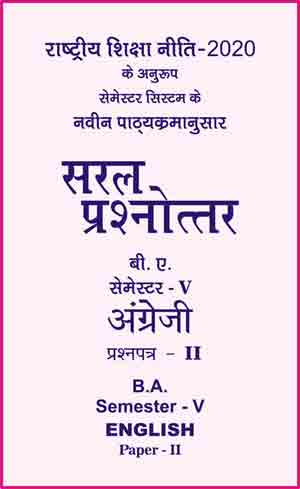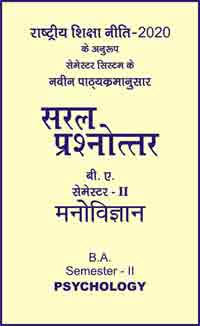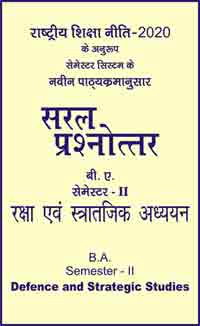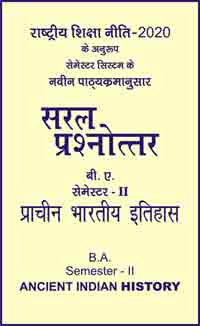|
बी ए - एम ए >> बीए सेमेस्टर-5 पेपर-2 अंग्रेजी बीए सेमेस्टर-5 पेपर-2 अंग्रेजीसरल प्रश्नोत्तर समूह
|
5 पाठक हैं |
|||||||
बीए सेमेस्टर-5 पेपर-2 अंग्रेजी - सरल प्रश्नोत्तर
Question- What is campus novel? Explain its history and development.
Or
What is the characteristics of campus novel?
Answer-
A campus novel is also called an academic novel. This is a novel whose main action is set in and around the campus of a university. The writers of campus novels had first-hand experience of teaching at various universities and colleges. The novelists have recorded their experiences in their works. They have woven the stories of their novels in or around the campus of the institutions.
The genre in its current form dates back to the early 1950s. The Concise Oxford Dictionary of Literary Terms defines.
"Campus novel is a novel, usually comic or satirical, in which the action is set within enclosed world of university (or similar set of learning) and highlights the follies of academic life."
Many novels have presented nostalgic evocations of college days, but the campus novel in the usual modern sense dated from the 1950's: Mary McCarthy's The Groves of Academe (1952) and Kingsley Amis's Lucky Jim (1952) began significant tradition in modern fiction including John Barth's Giles Goat Boy (1966), David Lodge's Changing Places (1975) and Robert Davis's The Rebel Angels (1982)"
Another scholar Martin Hilský gives us different definition of campus novel: it is a satirical comedy with strong elements of parody. In the same book, he argues that the genre of campus novel is influenced by the fact that universities gain importance in the Anglo-American world and that more and more authors of the campus novels are university teachers of English literature or creative writing.
History and Development of Campus Novel
Campus Novel dates back to the early 1950s. The Groves of Academe (1952) by Mary McCarthy is considered the earliest example of such kind of fiction. However, Elaine Showalter discusses C.P. Snow's The Masters of the previous year, and several earlier novels have an academic setting and the same characteristics, such as Willa Cather's The Professor's House of 1925, Régis Messac's Smith Conundrum first published between 1928 and 1931 and Dorothy L. Sayers' Gaudy Night of 1935.
Characteristics of Campus Novel
The campus novel generally deals with the internal affairs of a university or a college. It deals with the complex relationships among the faculty and the staff.
It presents a picture of the past memories of the members of the university, their experiences, power politics, conflicts and struggles of the characters. The campus novel presents the socio-cultural point of view of one of the members of the staff.
The campus novel abounds with scenes of drinking, partying, love- scenes, seduction, molestation, envy, exploitation and manipulation in the university or college campus. They are the inseparable part of campus novel.
Extra-marital relationships, adultery of the authorities have been focussed through the campus novels. The Campus novel also unveils the snobbery and hypocrisy of people!
There are also scenes of disparity and discrimination on the basis of caste, religion, culture, language and gender in the campus novel.
The campus novel presents the dirty picture of power politics within the academics. It also highlights class struggle and gender struggle. It also throws light on a clash between members of the staff on the basis of their position in the hierarchical order.
Though some of the campus novels have been written in comical vein, they have serious undercurrents. The views of the characters are presented by using satiric and sarcastic language.
Many campus novels have anti-heroes who are incompetent, unlucky, tactless and stupid. Kingsley Amis's Lucky Jim' is a fine example of an anti-hero.
The campus novel deals with the hopes and aspirations of characters, their failures, disillusionment, and discontentment. They were several novels with academic background and setting produced before the Second World War.
Examples of Campus Novel
Many well-known campus novels, such as Kingsley Amis's Lucky Jim and others by David Lodge, are comic or satirical. Such novels are often counterpointing intellectual pretensions and human weaknesses. Some, however, attempt a serious treatment of university life; examples include C. P. Snow's The Masters, J. M. Coetzee's Disgrace and. Philip Roth's The Human Stain. Novels such as Evelyn Waugh's Brideshead Revisited that focus on students rather than faculty are often considered to belong to a distinct genre, sometimes termed varsity novels.
Willa Sibert Cather's novel, The Professors House appeared in 1925. It deals with the story of a disillusioned and dejected middle-aged professor St Peter. The novel describes St Peter's memories of his favourite student, Outland who discovers an abandoned stone city created by Pueblo-Indians in the past.
Randall Jarrell's novel, pictures from an institution appeared in 1954. The novel has a nameless narrator. "Pictures from an Institution" presents keen and minute observation of students and the staff of the Benton Women's College.
In this novel, Randall Jarrell has satirized life in progressive women's college. The novel comments upon the oddities of academic life. It is said that the character of Gertrude is modelled on Mary McCarthy.
Vladimir Nabokov's novel, Prin was published in 1957. It deals with a story of Timothy Prin, a professor of Russian at fictional Waindell College.
Malcolm Bradbury's campus novel, eating people. is wrong was published in 1959.
The novel deals with the story of the relationship between Stuart Treece, a professor of English and his students. The novel is set in a provincial English university.
The novel presents Stuart Treece's failures as a professor and a lover. Stuart Treece realizes that his moral scruples and socialism are no longer appropriate and viable. He feels alienated and frustrated in the company of his young students. He also finds his professional career on the wane.
Another novel of Malcolm Bradbury, namely Stepping Westward appeared in 1965. The novel has setting of Midwest of America. It is an entertaining campus novel written in the style of David Lodge's "Changing Places".
Malcolm Bradbury's Stepping Westward was followed by his third novel, namely The History Man". It was published in 1975.
The novel is set in the University of Watermouth. Howard Kirk is the protagonist of the novel who is a lecturer in sociology. Howard Kirk and his wife, Barbara Kirk, detest exploitation, manipulation, manipulation, disparity and discrimination.
The novel presents many scenes of adultery, flirting, and seduction. For example, Barbara Kirk flirts with an Egyptian student behind her husband's back. Similarly, Howard also has illicit relationships with his student and faculty members.
John Barth's allegorical novel, Giles Goat-Boy abounds with allusions from mythology. John Barth has delineated the universe as a university campus. The novel is an allegory of Cold War. George Giles is the protagonist of the novel. The novel is a fine example of metafiction and it is written in comical vein with serious purpose.
John Barth's Giles Goat-Boy describes the spiritual development of the hero, George. "Giles Goat-Boy" was published in 1966.
Alison Lurie produced The War between the Tates in 1974. The novel deals with student politics, infidelity, marital anguish and teenage revolt.
The War between the Tates presents the turmoil and conflicts of the late 1960s. It describes upheavals in political and social spheres. Erica and Brian are the chief characters of the novel. They are successful academic couple.
A twist comes in the marital life when Jenny, a young student comes to their life. Jenny opposes sexist view of professor Dibble. Brian is allured by Jenny's beauty. The novel highlights the start of the feminist movement.
David Lodge's novel changing places has been considered as the first campus novel a British novelist. The novel is subtitled as A Tale of Two Campuses. It recalls Charles Dickens's novel The Tale of Two Cities.
The novel Changing Places was published in 1975. Philip Swallow and Morris Zapp are academic members of two different fictional universities. Philip Swallow has been portrayed as a British professor whereas Morris Zapp is an American professor.
The novel describes the story of the six-month academic exchange programme between the two universities. At the end of the novel, the readers come to know that both Philip Swallow and Morris Zapp have an affair with the other's wife. The exchange of the campuses of the two universities and exchange of wives shocks the readers.
David Lodge's Changing Places was followed by another novel Small World: An Academic Romance. It was published in 1984. The Novel alludes to Holy Grail and Edmund Spenser's Faerie Queene. The characters of Philip Swallow and Morris Zapp one again appear in the novel.
The last novel of David Lodge's 'Campus Trilogy' is, "Nice Work" which appeared in 1988.
The novel "Thinks..." by David Lodge has also got the setting of a Campus novel. It was in 2001.
Robertson Davies's novel, The Rebel Angels appeared in 1981. The novel deals with the story of several faculty members and the staff of the fictional College of St John and Holy Ghost.
Robertson Davies has recorded his experiences as a professor in the novel. The characters of Parlabane and Movarish have been modelled on college staff of Robertson Davies.
Another novel of Robertson Davies namely, What Bred in the Bone was published in 1985. It deals with the story of Francis Cornish. It is the second novel of Cornish Trilogy.
The novel What Bred in the Bone was followed by the last novel of the 'Cornish Trilogy', namely The Lyre of Orpheus which appeared in 1988. The novel presents scenes of exploitation, seduction and love affairs.
Howard Jacobson's Campus novel, Coming from Behind was published in 1983. The novel is set in a midlands polytechnic; it is written in satiric vein. Sefton Goldberg is the protagonist of the novel. He abhors his weaknesses.
The novel Coming from Behind presents realistic picture of depressed and demoralized lecturers in comic manner. It deals with humiliation, envy and helplessness of Sefton Goldberg.
John Maxwell Coetzee's famous novel Disgrace was published in 1999. The novel deals with a story of David Lurie, a professor of English who is charged with sexual harassment of Melanie Isaac, a student.
It is important to note that John Maxwell Coetzee is the first writer to win the Booker Prize twice. Disgrace won the Booker Prize in 1999.
The Human Stain of Philip Roth also holds some features of the Campus novel. It was published in 2000. The novel deals with a story of Coleman Silk, who is a retired professor of classics. The narrator of the novel is Nathan Zuckerman.
Tom Wolfe's novel, I am Charlotte Simmons appeared in 2004. It deals with a story of a college student Charlotte Simmons who is studying at fictional university. Charlotte is seduced by Hoyt and Adam.
Truth and Consequences of Alison Lurie appeared in 2005. It deals with the effects of pain on creative process and relationships. The protagonist of the novel is Alan Mackenzie who suffers from back-pain. Alan Mackenzie gets some relief when Delia, a visiting author, comes to his life.
Campus Novels by Indian Authors
R.K. Narayan's The Bachelor of Arts is considered to be the very first Indian campus novel in Indian English Writing. In India, people claim that six out of every 10 Indian campus novels now sell an average of 4,000 copies, making each a bestseller. The trend kicked in when Chetan Bhagat's five point someone sold more than 50,000 copies.
Best Campus Novels
Pictures from an Institution by Randall Jarrell (1954) Anglo-Saxon Attitudes by Angus Wilson (1956) Prin by Vladimir Nabokov (1957) Eating People is Wrong by Malcolm Bradbury (1959) On Beauty by Zadie Smith (2005) Blue Angel by Francine Prose (2006)
Beet: A Novel (P.S.) by Roger Rosenblatt (2008) Indignation by Philip Roth (2008)
Five Point Someone by Chetan Bhagat
|
|||||
- Question- Discuss in detail the development of English novel from the eighteenth century to the Modern Age.
- Question- What do you understand by Novel? What are the elements which are to considered in plot construction.
- Question- Write a note on characterization of a novel. How much is it important for development of a novel?
- Question- Write a short note on narrative technique of a novel.
- Question- Write a note on the elements of a short story.
- Question- Write a note on Fielding's plot construction.
- Question- Write a note on Fielding's characterisation.
- Question- Define plot. What are the qualities of an ideal plot ?
- Question- Write a short note on the plot construction of a novel.
- Question- What is the difference between Flat Character and Round Character?
- Question- Write a short note on the characterization of a novel.
- Question- Write a short note on narrative technique of a novel.
- Question- What is a short story? What is the difference between a short story and a novel?
- Question- What is a picaresque novel? Who are the main exponents of the picaresque novel?
- Question- What is a historical novel? What is the difference between history and a historical novel? Name a few historical novelists and their creation.
- Question- What do you know about the Gothic novel?
- Question- Write a note on Epistolary novel.
- Question- Write a note on the Regional novel.
- Question- Point out the chief characteristics of the Picaresque novel.
- Question- Point out the chief characteristics of the historical novel.
- Question- Write an essay on Sir Walter Scott's contribution to historical novel.
- Question- Point out the chief characteristics of Gothic novel.
- Question- Point out the chief characteristics of the Regional novel.
- Question- What is a regional novel? Name a few novelists of this genre and their novels.
- Question- What is a Picaresque novel?
- Question- What do you know about Historical novel?
- Question- What do you know about Gothic novel?
- Question- Examine the merits of Sir Walter Scott as a Historical novelist.
- Question- What do you mean by domestic novel?
- Question- What do you mean by the Stream of consciousness? Who. coined the term?
- Question- What is a Epistolary novel?
- Question- What do you know about the Regional novel?
- Question- Trends in 20th and 21st Century Fiction Discuss as a sub-genre of crime fiction and mystery.
- Question- Define utopian fiction. Discuss its history and origin.
- Question- What is campus novel? Explain its history and development.
- Question- Write a note on Detective novel.
- Question- Write a note on Science fictions.
- Question- Write a note on Meta fiction.
- Question- Define mythology. Explain the rise of mythological fiction in India.
- Question- What is space fiction? Discuss its characteristics and example.
- Question- Define chick lit. Discuss its characteristics and example.
- Question- Define junk fiction. Explain its characteristics and types of junk fiction.
- Question- Write a short note on detective novel.
- Question- Write short note on Science fiction.
- Question- What is Meta fiction?
- Question- What is Science Fiction?
- Question- What is utopian fiction?
- Question- Why are campus novels important? What kind of characters are in campus novels?
- Question- What is dystopian fiction?
- Question- Discuss feminism in mythological fiction.
- Question- Why are campus novels important? What kind of characters are in campus novels?
- Question- What is chic lit fiction?
- Question- Write a note on the life and works of Charles Dickens.
- Question- Write a note on Charles Dickens as a novelist.
- Question- Write a note on the development of English novel up to Dickens.
- Question- Write a note on Dicken's social criticism. What was Dickens' attitude toward various social evils of the day?
- Question- Describe Dickens as a representative of his age.
- Question- Write a note on Dickens as a social reformer.
- Question- Write a note on the social background of Dickens.
- Question- Write a note on Dickens's contribution to English novel.
- Question- Discuss symbolism as a structural elements in A Tale of two cities.
- Question- Discuss Dickens's art of characterization in the novel "A Tale of Two Cities".
- Question- What is meant by criticism of life? What is the 'vision of life"? Point out the criticism and vision of life in A Tale of Two Cities.
- Question- Write a note on the blend of realism and idealism in the novels of Dickens.
- Question- "Dickens' characters are both types and individuals.” Discuss.
- Question- Write a note on Dickens as a satirist.
- Question- What is the significance of the name "Jacques" in A Tale of Two Cities?
- Question- In Book 2, Chapter 21 of A Tale of Two Cities, what is happening in France that upsets Mr. Jarvis Lorry?
- Question- Write the life of Thomas Hardy and about his career.
- Question- What are the three phases of Hardy's writing? What were the issues he dealt with in those three phases?
- Question- Write short notes on the major characters of the novel, and show how Hardy develops these characters in the course of the novel.
- Question- Who is the heroine of 'Far From the Madding Crowd"? How doy o you justify her position as the heroine?
- Question- Explain the tragic vision of Hardy in Far From the Mad ding Crowd.
- Question- Why does Bathsheba reject Gabriel's proposal at the start of the novel?
- Question- How is sexual desire portrayed in the novel?
- Question- How was Oak's life saved by Bathsheba?
- Question- How was Oak completely ruined?
- Question- Describe the feast after sheep-shearing.
- Question- How are Oak and Bathsheba ultimately a happy couple?
- Question- Discuss Jane Austen as a realist.
- Question- Point out Jane Austen's contribution to the English novel.
- Question- Write a note on characterisation of Jane Austen with special reference to 'Pride and Prejudice'.
- Question- Is there artistic detachment in Jane Austen ? Write a brief note in support to your view with illustrations.
- Question- Sketch the character of Fitzwilliam Darcy.
- Question- Sketch the character of George Wickham.
- Question- Do you agree with the view that the novel 'Pride and Prejudice' revolves around two themes of 'Pride and Prejudice'? Give reasons for your answer?
- Question- Write an essay on the sequence of events in 'Pride and Prejudice'?
- Question- Write a note on Life Sketch of George Eliot Life Sketch of George Eliot
- Question- Discuss the humour elements in George Eliot's The Mill on the Floss.
- Question- Critically examine the artistic and the philosophic dimensions of the ending of The Mill on the Floss in the light of the view of the individual and society presented in the novel.
- Question- Compare and contrast Maggie's love for Philip, Stephen, and Tom.
- Question- Describe the thematic import of Maggie's decision to relinquish Stephen.
- Question- Compare and contrast Tom and Maggie. How much are their respective successes and failures a function of gender and how much a function of their distinct characteristics?
- Question- Compare and contrast Tom and Mr. Tulliver. Why does Tom succeed where Mr. Tulliver failed?
- Question- Write a note on life kketch of Toni Morrison.
- Question- Discuss the narrative strategies used by the writer in The Bluest Eye.
- Question- Discuss the narrative structure of the novel. Why might Morrison have chosen to present the events in a non- chronological way?
- Question- What does the title of The Bluest Eye mean?
- Question- How are Pecola Breedlove and Maureen Peal foils to one another?
- Question- The Bluest Eye uses multiple narrators, including Claudia as a child, Claudia as an adult, and an omniscient narrator. Which narrative point of view doyou think is most central to the novel and why?
- Question- Who do you think is the most sympathetic character in the novel and why?
- Question- The Bluest Eye is a novel about racism, and yet there are relatively few instances of the direct oppression of black people by white people in the book. Explain how racism functions in the story.
- Question- Write a note on Life Sketch of The Harper Lee.
- Question- Analyze the childhood world of Jem, Scout, and Dill and their relationship with Boo Radley in Part One.
- Question- What is Atticus's relationship to the rest of Maycomb? What is his role in the community?
- Question- Discuss the role of family in To Kill a Mockingbird, paying close attention to Aunt Alexandra.
- Question- Discuss the author's descriptions of Maycomb. What is the town's role in the novel? Analyze the author's treatment of Boo Radley. What is his role in the novel?
- Question- Discuss Atticus's parenting style. What is his relationship to his children like? How does he seek to instill conscience in them?
- Question- Identify Atticus Finch, Jean Louise (Scout) Finch, Jem Finch, Maycomb, Calpurnia, Charles Baker (Dill) Harris, The Radley Place, Stephanie Crawford, Arthur (Boo) Radley, Miss Caroline Fisher, Walter Cunningham, and Burris Ewell.
- Question- Why did Mr. Cunningham's mob leave?
- Question- In Chapter 2 of To Kill a Mockingbird what does Miss Caroline, Scout's first-grade teacher, represent?
- Question- In Chapter 6 of To Kill a Mockingbird why is Jem is determined to retrieve his pants from the fence despite the danger of meeting up with Nathan Radley?
- Question- What is the significance of the title To Kill a Mockingbird according to Atticus's reasoning in Chapter 10?
- Question - Comment upon the role of the lions in The Old Man And The Sea.
- Question- Comment upon the symbolic role played by Di Maggio in the novel "The Old Man And The Sea'...
- Question- Comment upon the arm-wrestling episode in the novel 'The Old Man and The Sea'.
- Question- Comment upon the marlin separating episode in the novel "The Old Man and The Sea".
- Question- Write a note on the major themes of the novel The Old Man and The Sea'.
- Question- Write a brief note on The Old Man And The Sea' as a tragedy.
- Question- Which claims your attention more in The Old Man And The Sea' its narrative or allegory?
- Question- The hero of the novel "The Old Man And The Sea' is really a Christfigure. Comment.
- Question- Write a brief note on Hemingway hero or the autobiographical hero.
- Question- In the fight of the old man against the giant fish what we see is a "battle of attrition". Comment.
- Question- Write a note on Life Sketh of John Ernst Steinbeck.
- Question- Analyze Tom Joad's growth throughout the novel. Despite the fact that Tom is not a young boy, does the novel have the characteristics of a bildungsroman, or coming-of-age story?
- Question- Discuss the development of Tom Joad as a character. How does he grow throughout the book? What effects do Jim Casy's imprisonment and death have on his development?
- Question-What themes related to family are in The Grapes of Wrath?
- Question- How does the erosion described in Chapter 1 of The Grapes of Wrath relate to the Bank monster described in Chapter 5?
- Question- How do the roles of Ma and Pa differ in the Joad family in The Grapes of Wrath?
- Question- In The Grapes of Wrath how is the Gila monster described in Chapter 13 comparable the Bank monster?
- Question- What biblical allusions does John Steinbeck include in The Grapes of Wrath and how does he use them?
- Question- How do the roles of Ma Joad and Pa Joad within the family change in The Grapes of Wrath?
- Question- In The Grapes of Wrath, why does the Joad family deteriorate after the Joads leave Oklahoma?
- Question- Write a note on Life Sketch of Aravind Adiga
- Question- Discuss plot of the novel The White Tiger.
- Question- Explain literary analysis of The White Tiger by Aravind Adiga.
- Question- Critical analysis of the novel The White Tiger written by Aravind Adiga.
- Question- What is Balram's attitude toward religion? How does this develop throughout the novel?
- Question- How does this portrayal of India differ from more typical literary depictions of India?
- Question- Why does Balram choose to address his narrative to the Premier of China? How would the story have been different without this framing device?
- Question- Discuss Balram's many names throughout the novel, and how each one represents an aspect of him.
- Question- What does Balram's experience in Bangalore reveal about the Indian economy in an increasingly globalized world?
- Question- Attempt critical analysis of the novel 'Dalits, Dynasty and She' by Sanjay Chitranshi.
- Question- Explain the plot of the novel 'Dalits, Dynasty and She 'written by Sanjay Chitranshi.
- Question- Discuss the Novel 'Dalits, Dynasty and She' by Sanjay Chitranshi.
- Question- Who was Shanti Devi?
- Question- Write a' character sketch of Ram Chandra.
- Question- Write a note on Life Sketch of Sudha Murty.
- Question- What are the major themes of the novel "Dollar Bahu"?
- Question- Discuss how the notion of self sacrifice is exclusively attributed to a particular gender in Indian society. How they thrive through the difficult situation in life when they are implanted to a new atmosphere.
- Question- Write a note on the title "Dollar Bahu?".
- Question- Write a note on the end of the novel "Dollar Bahu".
- Question- Discuss the central theme of Dollar Bahu.














